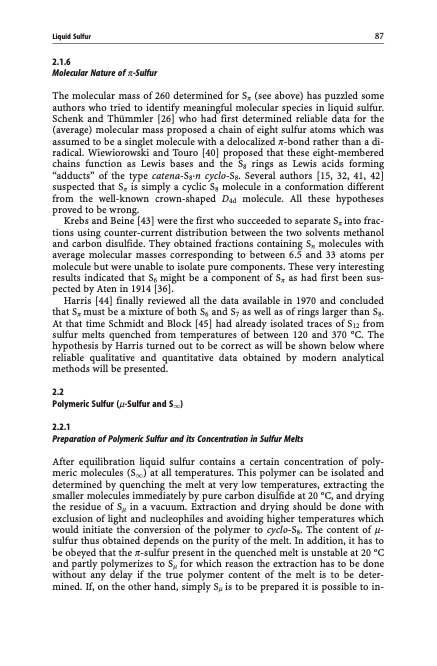
PDF Publication Title:
Text from PDF Page: 097
Liquid Sulfur 87 2.1.6 Molecular Nature of p-Sulfur The molecular mass of 260 determined for Sp (see above) has puzzled some authors who tried to identify meaningful molecular species in liquid sulfur. Schenk and Thümmler [26] who had first determined reliable data for the (average) molecular mass proposed a chain of eight sulfur atoms which was assumed to be a singlet molecule with a delocalized p-bond rather than a di- radical. Wiewiorowski and Touro [40] proposed that these eight-membered chains function as Lewis bases and the S8 rings as Lewis acids forming “adducts” of the type catena-S8·n cyclo-S8. Several authors [15, 32, 41, 42] suspected that Sp is simply a cyclic S8 molecule in a conformation different from the well-known crown-shaped D4d molecule. All these hypotheses proved to be wrong. Krebs and Beine [43] were the first who succeeded to separate Sp into frac- tions using counter-current distribution between the two solvents methanol and carbon disulfide. They obtained fractions containing Sn molecules with average molecular masses corresponding to between 6.5 and 33 atoms per molecule but were unable to isolate pure components. These very interesting results indicated that S6 might be a component of Sp as had first been sus- pected by Aten in 1914 [36]. Harris [44] finally reviewed all the data available in 1970 and concluded that Sp must be a mixture of both S6 and S7 as well as of rings larger than S8. At that time Schmidt and Block [45] had already isolated traces of S12 from sulfur melts quenched from temperatures of between 120 and 370 C. The hypothesis by Harris turned out to be correct as will be shown below where reliable qualitative and quantitative data obtained by modern analytical methods will be presented. 2.2 Polymeric Sulfur (m-Sulfur and S1) 2.2.1 Preparation of Polymeric Sulfur and its Concentration in Sulfur Melts After equilibration liquid sulfur contains a certain concentration of poly- meric molecules (S1) at all temperatures. This polymer can be isolated and determined by quenching the melt at very low temperatures, extracting the smaller molecules immediately by pure carbon disulfide at 20 C, and drying the residue of Sm in a vacuum. Extraction and drying should be done with exclusion of light and nucleophiles and avoiding higher temperatures which would initiate the conversion of the polymer to cyclo-S8. The content of m- sulfur thus obtained depends on the purity of the melt. In addition, it has to be obeyed that the p-sulfur present in the quenched melt is unstable at 20 C and partly polymerizes to Sm for which reason the extraction has to be done without any delay if the true polymer content of the melt is to be deter- mined. If, on the other hand, simply Sm is to be prepared it is possible to in-PDF Image | Topics in Current Chemistry

PDF Search Title:
Topics in Current ChemistryOriginal File Name Searched:
Elemental-Sulfur-und-Sulfur-Rich-Compounds-I.pdfDIY PDF Search: Google It | Yahoo | Bing
Sulfur Deposition on Carbon Nanofibers using Supercritical CO2 Sulfur Deposition on Carbon Nanofibers using Supercritical CO2. Gamma sulfur also known as mother of pearl sulfur and nacreous sulfur... More Info
CO2 Organic Rankine Cycle Experimenter Platform The supercritical CO2 phase change system is both a heat pump and organic rankine cycle which can be used for those purposes and as a supercritical extractor for advanced subcritical and supercritical extraction technology. Uses include producing nanoparticles, precious metal CO2 extraction, lithium battery recycling, and other applications... More Info
| CONTACT TEL: 608-238-6001 Email: greg@infinityturbine.com | RSS | AMP |